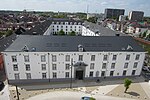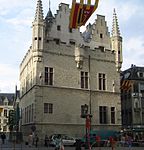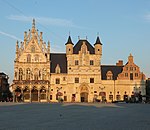Mechelen transit camp

The Mechelen transit camp, officially SS-Sammellager Mecheln (lit. 'SS Assembly Camp Mechelen') in German, also known as the Dossin barracks, was a detention and deportation camp established in a former army barracks at Mechelen in German-occupied Belgium. It served as a point to gather Belgian Jews and Romani ahead of their deportation to concentration and extermination camps in Eastern Europe during the Holocaust. The camp was established in March 1942 and was the only transit camp in Belgium. It was managed by the Sicherheitspolizei (SiPo-SD), a branch of the Reich Security Main Office, and was used to hold Jews and Romani ahead of their deportation to Auschwitz-Birkenau as well as other camps including Heydebreck-Cosel. Between 4 August 1942 and 31 July 1944, 28 trains left from near the camp and deported over 25,800 people. Only 1,240 survived the war.The camp was abandoned at the Liberation of Belgium in September 1944 and subsequently was repurposed for housing. A museum was established in 1996 and today part of the former barracks and a new building opposite form part of the Kazerne Dossin – Memorial, Museum and Documentation Centre on Holocaust and Human Rights, which includes a Holocaust memorial and museum.
Excerpt from the Wikipedia article Mechelen transit camp (License: CC BY-SA 3.0, Authors, Images).Mechelen transit camp
Nokerstraat, Mechelen
Geographical coordinates (GPS) Address Nearby Places Show on map
Geographical coordinates (GPS)
| Latitude | Longitude |
|---|---|
| N 51.033888888889 ° | E 4.4783333333333 ° |
Address
Nokerstraat 13;11;5;7;9
2800 Mechelen (Mechelen)
Antwerp, Belgium
Open on Google Maps








